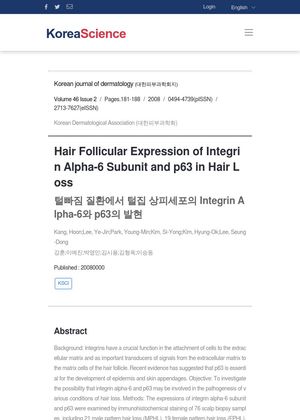TLDR Integrin alpha-6 and p63 proteins may play a role in hair loss and are important for hair growth and maintenance.
The study, conducted 15 years ago, investigated the role of integrin alpha-6 and p63 in various conditions of hair loss by examining their expressions in 76 scalp biopsy samples. These samples included 21 cases of male pattern hair loss (MPHL), 19 of female pattern hair loss (FPHL), 23 of alopecia areata (AA), and 13 of female telogen effluvium (TE). The results showed that MPHL and AA had nearly negative immunoreactivities of alpha-6 integrin in the basal sides of follicle epithelium, while TE showed a pattern similar to normal control and FPHL samples showed weak outer root sheath staining. p63 staining in AA and TE was relatively strong compared to MPHL and FPHL. The findings suggested a potential causal and developmental role of integrin alpha-6 and p63 in hair loss, indicating the importance of these proteins in hair follicle growth and maintenance.
1 citations
,
November 2021 in “Revista Científica Hospital Santa Izabel” Adhesion molecules are crucial for fetal hair growth.
 53 citations
,
April 2014 in “Experimental Dermatology”
53 citations
,
April 2014 in “Experimental Dermatology” Wnt10b makes hair follicles bigger, but DKK1 can reverse this effect.
6 citations
,
March 2011 in “European Journal of Dermatology” Nestin-positive cells are important for hair follicle regeneration in alopecia areata.
 235 citations
,
January 2011 in “Journal of Clinical Investigation”
235 citations
,
January 2011 in “Journal of Clinical Investigation” Men with baldness due to androgenetic alopecia still have hair stem cells, but lack specific cells needed for hair growth.
 5 citations
,
January 2009 in “Dermato-endocrinology”
5 citations
,
January 2009 in “Dermato-endocrinology” ADAM 10 and ADAM 12 proteins are involved in different stages of hair growth and could be targets for treating hair disorders.
 88 citations
,
May 2005 in “Journal of Dermatological Science”
88 citations
,
May 2005 in “Journal of Dermatological Science” Versican, a protein, is less present in thinning hair follicles and this decrease might contribute to common hair loss in men.
27 citations
,
May 2004 in “Journal of Investigative Dermatology”  146 citations
,
May 2002 in “The American journal of pathology”
146 citations
,
May 2002 in “The American journal of pathology” Cathepsin L is essential for normal hair growth and development.
45 citations
,
April 2001 in “The journal of investigative dermatology/Journal of investigative dermatology” Different Myc family proteins are located in various parts of the hair follicle and may affect stem cell behavior.
87 citations
,
February 2000 in “Journal of Investigative Dermatology” Stem cells in developing hair follicles move to specific areas as they mature.





